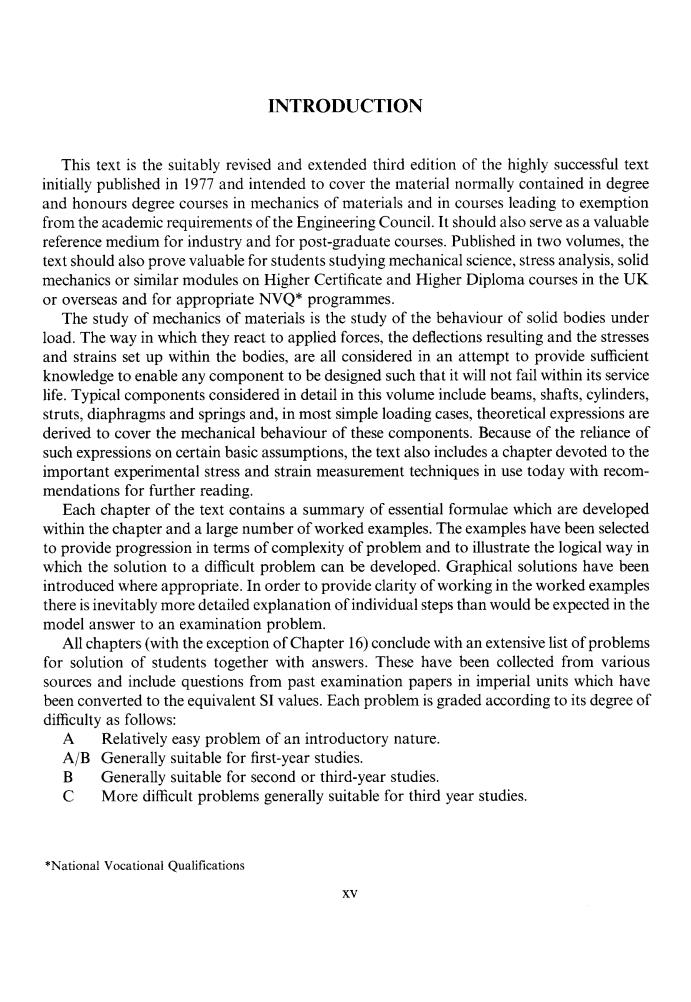正在加载图片...

INTRODUCTION This text is the suitably revised and extended third edition of the highly successful text initially published in 1977 and intended to cover the material normally contained in degree and honours degree courses in mechanics of materials and in courses leading to exemption from the academic requirements of the Engineering Council.It should also serve as a valuable reference medium for industry and for post-graduate courses.Published in two volumes,the text should also prove valuable for students studying mechanical science,stress analysis,solid mechanics or similar modules on Higher Certificate and Higher Diploma courses in the UK or overseas and for appropriate NVQ*programmes. The study of mechanics of materials is the study of the behaviour of solid bodies under load.The way in which they react to applied forces,the deflections resulting and the stresses and strains set up within the bodies,are all considered in an attempt to provide sufficient knowledge to enable any component to be designed such that it will not fail within its service life.Typical components considered in detail in this volume include beams,shafts,cylinders, struts,diaphragms and springs and,in most simple loading cases,theoretical expressions are derived to cover the mechanical behaviour of these components.Because of the reliance of such expressions on certain basic assumptions,the text also includes a chapter devoted to the important experimental stress and strain measurement techniques in use today with recom- mendations for further reading. Each chapter of the text contains a summary of essential formulae which are developed within the chapter and a large number of worked examples.The examples have been selected to provide progression in terms of complexity of problem and to illustrate the logical way in which the solution to a difficult problem can be developed.Graphical solutions have been introduced where appropriate.In order to provide clarity of working in the worked examples there is inevitably more detailed explanation of individual steps than would be expected in the model answer to an examination problem. All chapters(with the exception of Chapter 16)conclude with an extensive list of problems for solution of students together with answers.These have been collected from various sources and include questions from past examination papers in imperial units which have been converted to the equivalent SI values.Each problem is graded according to its degree of difficulty as follows: A Relatively easy problem of an introductory nature. A/B Generally suitable for first-year studies. B Generally suitable for second or third-year studies. C More difficult problems generally suitable for third year studies. *National Vocational Qualifications XVINTRODUCTION This text is the suitably revised and extended third edition of the highly successful text initially published in 1977 and intended to cover the material normally contained in degree and honours degree courses in mechanics of materials and in courses leading to exemption from the academic requirements of the Engineering Council. It should also serve as a valuable reference medium for industry and for post-graduate courses. Published in two volumes, the text should also prove valuable for students studying mechanical science, stress analysis, solid mechanics or similar modules on Higher Certificate and Higher Diploma courses in the UK or overseas and for appropriate NVQ* programmes. The study of mechanics of materials is the study of the behaviour of solid bodies under load. The way in which they react to applied forces, the deflections resulting and the stresses and strains set up within the bodies, are all considered in an attempt to provide sufficient knowledge to enable any component to be designed such that it will not fail within its service life. Typical components considered in detail in this volume include beams, shafts, cylinders, struts, diaphragms and springs and, in most simple loading cases, theoretical expressions are derived to cover the mechanical behaviour of these components. Because of the reliance of such expressions on certain basic assumptions, the text also includes a chapter devoted to the important experimental stress and strain measurement techniques in use today with recommendations for further reading. Each chapter of the text contains a summary of essential formulae which are developed within the chapter and a large number of worked examples. The examples have been selected to provide progression in terms of complexity of problem and to illustrate the logical way in which the solution to a difficult problem can be developed. Graphical solutions have been introduced where appropriate. In order to provide clarity of working in the worked examples there is inevitably more detailed explanation of individual steps than would be expected in the model answer to an examination problem. All chapters (with the exception of Chapter 16) conclude with an extensive list of problems for solution of students together with answers. These have been collected from various sources and include questions from past examination papers in imperial units which have been converted to the equivalent SI values. Each problem is graded according to its degree of difficulty as follows: A Relatively easy problem of an introductory nature. A/B Generally suitable for first-year studies. B Generally suitable for second or third-year studies. C More difficult problems generally suitable for third year studies. *National Vocational Qualifications xv